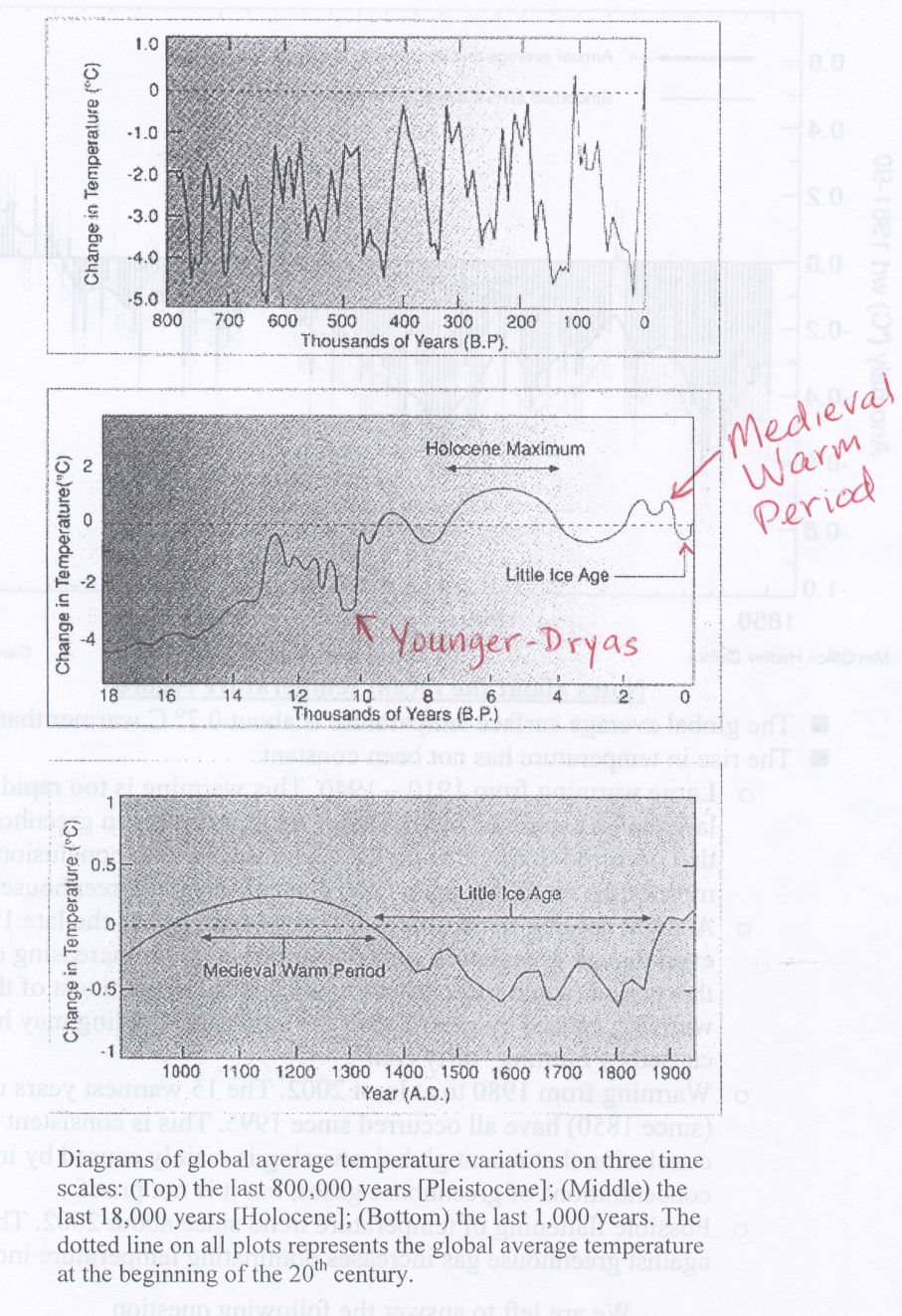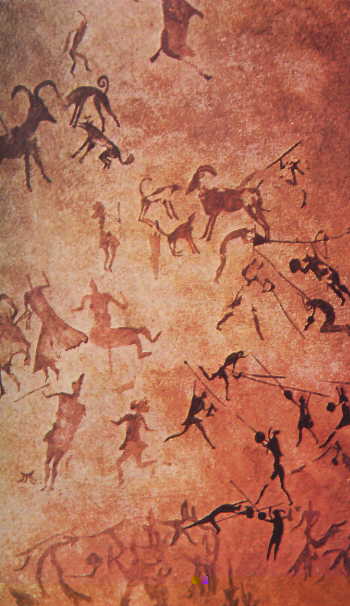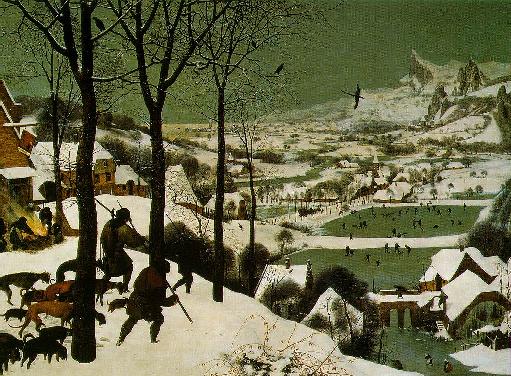The last glacial maximum (Ice Age) ended about 15 thousand years ago. The most recent glacial retreat is still going on. We call the current period of glacial retreat the Holocene epoch and it continues until present. This page discusses the climate changes within the Holocene Epoch or the current interglacial period from its beginning up until about the year 1900. Prior to the year 1900 most climate changes are considered natural in that the changes could not have been caused by human activity. We will cover the temperature changes over the last 150 years on a separate page, since that is the period when human influence may have significantly impacted climate change. I am leaving in a lot of information about how human civilizations were affected by climate changes during the Holocene in these notes, but we will not have time to cover the human impacts in much detail. I expect that you know something about the timing and significance of four named periods within the Holocene: the Younger Dryas, the Holocene Maximum, the Medieval Warm Period, and the Little Ice Age.
The figure below shows a common reconstruction (based on proxy records) of the global average temperature changes that have taken place on Earth over the last 800,000 years. On each of the three graphs, the dotted line (for 0 temperature change) is referenced to the global average temperature in the year 1900. Thus, plots show the estimated difference in global average temperature relative to the year 1900. The Ice Age cycles (alternating glacial / interglacial periods) are easily seen in the top graph, which covers the last half of the Pleistocene. The middle graph shows the Holocene Epoch and highlights the four periods mentioned above. The bottom graph shows that even in the last 1000 years there are significant natural fluctuations in global average temperature.

The figure above shows that variations in the global average temperatures over the Holocene period have been relatively small compared to the ice age cycles, especially over the last 10,000 years. (Note that the vertical scale of temperature change is different for each of the graphs). However, even these relatively small variations in global average temperature over the last 10,000 years have been significant in terms of their effects on human development and civilations as described below.
![[Temperatures of the Last 18,000 years]](fig1.gif) |
| Temperatures of the Last 18,000 years |
Warming of Earth and glacial retreat began about 14,000 years ago (12,000 BC). The warming was shortly interrupted by a sudden cooling at about 10,000 - 8500 BC known as the Younger-Dryas. The warming resumed by 8500 BC. The younger-dryas event is significant because it shows that even during an otherwise tranquil period (the current interglacial), rapid climate shifts can still occur. You should know the important points listed at the bottom of this Younger-Dryas Page

By 5000 to 3000 BC average global temperatures reached their maximum level during the Holocene and were 1 to 2 degrees Celsius warmer than they are today. Climatologists call this period either the Climatic Optimum or the Holocene Optimum.
During the climatic optimum many of the Earth's great ancient civilizations began and flourished. In Africa, the Nile River had three times its present volume, indicating a much larger tropical region. 6,000 years ago the Sahara was far more fertile than today and supported large herds of animals, as evidenced by the Tassili N'Ajjer frescoes of Algeria (right).
You should be familar with the name, timing, and significance to human civilization for the Climatic or Holocene Optimum. Interestingly, you will notice that events labeled "optimum" correspond to relatively warm periodsFrom 3000 to 2000 BC a cooling trend occurred. This cooling caused large drops in sea level and the emergence of many islands (Bahamas) and coastal areas that are still above sea level today.
A short warming trend took place from 2000 to 1500 BC, followed once again by colder conditions. Colder temperatures from 1500 - 750 BC caused renewed ice growth in continental glaciers and alpine glaciers, and a sea level drop of between 2 to 3 meters below present day levels.
The period from 750 BC - 800 AD saw warming up to 150 BC. Temperatures, however, did not get as warm as the Climatic Optimum. During the time of Roman Empire (150 BC - 300 AD) a cooling began that lasted until about 900 AD, although Global average temperature remained relatively warm until about 600 AD. From 600-900 AD (The "Dark Ages"), global average temperatures were significantly colder than today. At its height, the cooling caused the Nile River (829 AD) and the Black Sea (800-801 AD) to freeze.
![[Temperatures of the Last 1,000 years]](fig2.gif)
The period 1100 - 1300 AD has been called either the Little Climatic Optimum or the Medieval Warm Period. It represents the warmest climate since the Climatic Optimum.
![[Viking ruins in Greenland]](hvalseychurch.jpg) |
| Hvalsey church, in southwest Greenland, is the best-preserved artifact of Norse Greenlanders, who mysteriously disappeared in the 15th century. |
 |
| The cold winters of the little Ice Age were recorded in Dutch and Flemish paintings such as Hunters in the Snow by Pieter Bruegel (c. 1525-69) |
During this period, the Vikings established settlements on Greenland and Iceland. The snow line in the Rocky Mountains was about 370 meters above current levels.
A period of cool and more extreme weather followed the Little Climatic Optimum. There are records of floods, great droughts and extreme seasonal climate fluctuations up to the 1400s. Horrendous floods devastated China in 1332 (reported to have killed several million people).
A great drought in the American southwest occurred between 1276 and 1299. During this period occurred the abandonment of settlements in the Southwest United States, including those in Chaco Canyon and Mesa Verde. Tree ring analysis has identified a period of "no" rain between 1276 and 1299 in these areas.
From 1550 to 1850 AD global temperatures were at their coldest since the beginning of the Holocene. Scientists call this period the Little Ice Age.
During the Little Ice Age, the average annual temperature of the Northern Hemisphere was about 1 degree Celsius lower than today.
Extreme weather during this period might have played an important role in the genesis of the Black Death (bubonic plague).
The Little Ice Age was not continuously cold: the 13th-14th centuries were cold; followed by an interval of more favorable conditions; then a return of more severe weather mid 16th-mid 19th centuries.
During the period 1580 to 1600, the western United States experienced one of its longest and most severe droughts in the last 500 years. Cold weather in Iceland from 1753 and 1759 caused 25% of the population to die from crop failure and famine. Newspapers in New England were calling 1816 the year without a summer.
You should know the information and points made below about the Medieval Warm Period and the Little Ice Age. For theses events we have very nice written historical records.
During the Medieval warm period (1100-1300 AD), global average temperatures were only 1°C (or less) warmer than in 1900, but in Europe:
During the Little ice age (1550-1850 AD), global average temperatures were only 1°C (or less) cooler than in 1900, but in Europe:
These events provide evidence that:
The table below summarizes some of the climate changes that have occurred during the current interglacial period or Holocene Epoch. You do not have to memorize the table. Just realize that all of the fluctuations listed, except possibly the last entry (1850-present), happened naturally, i.e., they were not caused by human activities. We will discuss the contempory climate period next.
| Period | Name | Climate conditions |
|---|---|---|
| 14,000 years ago | Holocene warming | Slow warming from the last ice age; large ice melt |
| 10,000 - 8500 BC | Younger-Dryas | Rapid cooling, prolonged cold period, then Rapid warming |
| 5000 - 3000 BC | Climatic optimum | Warm conditions; temperatures were perhaps 1 to 2 degrees Celsius warmer than they are today. Great ancient civilizations began and flourished. |
| 3000 - 2000 BC | Cooling trend; drops in sea level and the emergence of many islands. | |
| 2000 - 1500 BC | Short warming trend | |
| 1500 - 750 BC | Colder temperatures and renewed ice growth, sea level drop of between 2 to 3 meters below present day levels. | |
| 750 BC - 150 BC | Slight warming not as warm as the Climatic Optimum. | |
| 150 BC - 900 AD | Cooling trend; Nile River (829 AD) and Black Sea (800-801 AD) froze | |
| 1100 - 1300 AD | Little Climatic Optimum or Medieval Optimum | Warm; warmest climate since the Climatic Optimum, Vikings established settlements on Greenland and Iceland. |
| 1300 - 1550 AD | Cool and more extreme weather; abandonment of settlements in the Southwest United States, | |
| 1550 to 1850 AD | Little Ice Age | Coldest temperatures since the beginning of the Holocene. Populations die from crop failure and famine in Europe. |
| 1850 AD - present | Contemporary climate | Warming trend |